Unveiling the Mysteries of Gravitational Waves and Black Holes: A Cosmic Dance of Epic Proportions
In the vast expanse of the cosmos, where darkness and gravity dominate, there exists a mesmerizing phenomenon that has captivated the imagination of scientists for decades – the celestial dance of gravitational waves and black holes. These enigmatic cosmic entities have fascinated astronomers and physicists alike, pushing the boundaries of our understanding of the universe. In this article, we will embark on a thrilling journey, exploring the intricacies of gravitational waves and delving into the enigmatic nature of black holes. From their astonishing discovery to their profound implications, we will unravel the complex relationship between these celestial wonders and shed light on the groundbreaking research that continues to propel our knowledge of the cosmos to new frontiers. Get ready to immerse yourself in an exhilarating cosmic odyssey!
Contents
- What are Gravitational Waves?
- Discovery of Gravitational Waves
- Black Holes: A Closer Look
- The Connection Between Gravitational Waves and Black Holes
- Implications of Gravitational Waves and Black Holes
- Current and Future Research
-
Conclusion
- 1. Brief Overview of Black Holes
- 2. Formation of Black Holes
- 3. The Theory of General Relativity
- 4. Einstein’s Prediction of Gravitational Waves
- 5. The LIGO Experiment
- 6. Detection of the First Gravitational Wave
- 7. Observing Black Holes through Gravitational Waves
- 8. The Collisions of Black Holes
- 9. Gravitational Waves as Probes of the Universe
- 10. Multimessenger Astronomy
-
Frequently Asked Questions
- 1. How do gravitational waves differ from electromagnetic waves?
- 2. Can gravitational waves be detected on Earth?
- 3. How fast do gravitational waves travel?
- 4. What are the potential sources of gravitational waves?
- 5. What can detecting gravitational waves tell us about the universe?
- 6. Can gravitational waves help us understand black holes better?
- 7. How accurate are gravitational wave detectors?
- 8. What is multimessenger astronomy?
- 9. Can gravitational waves be used for communication?
- 10. What can we expect from future research on gravitational waves?
- References
-
Frequently Asked Questions
- 1. How do black holes form?
- 2. Can gravitational waves be seen with the naked eye?
- 3. How fast do gravitational waves travel?
- 4. Are all black holes the same size?
- 5. Can gravitational waves pass through matter?
- 6. How are black holes detected?
- 7. Are there any risks associated with gravitational waves?
- 8. Can black holes collide with each other?
- 9. How do gravitational waves provide insight into the early universe?
- 10. Can gravitational waves be used for communication?
- References
- Read More
What are Gravitational Waves?
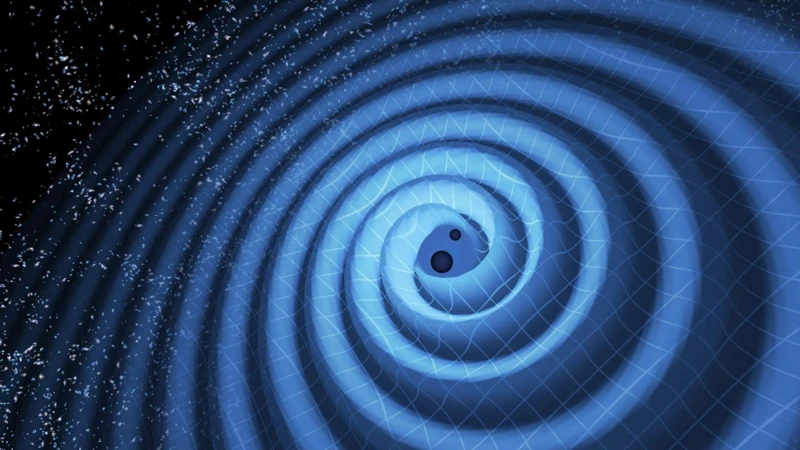
Gravitational waves are ripples in the fabric of spacetime, caused by the acceleration or movement of massive objects. According to Einstein’s theory of general relativity, these waves propagate outwards from their source and carry energy with them. They are the result of the warping and bending of spacetime itself, caused by the presence of massive bodies. Just as a pebble creates ripples on the surface of a pond, the motion of massive objects, such as colliding black holes or neutron stars, creates gravitational waves that spread through the universe at the speed of light. These waves can stretch and compress space as they pass, causing minuscule changes in the distances between objects. To better understand the nature of gravitational waves, let’s take a closer look at their key characteristics:
- Transverse Nature: Gravitational waves are transverse waves, meaning that the oscillations happen perpendicular to the direction of propagation. This is in contrast to longitudinal waves, where the oscillations occur parallel to the direction of travel.
- Tensor Nature: Gravitational waves are described mathematically as tensors, which are objects that represent the curvature of spacetime.
- Gravitational Wave Strain: The strength of a gravitational wave is measured by its “strain,” which quantifies the fractional change in distance between two objects caused by the wave passing through them.
- Frequency and Amplitude: Gravitational waves have a characteristic frequency and amplitude, which determine their properties and the effects they produce.
These extraordinary waves have the potential to provide us with invaluable insights into the nature of the universe, allowing us to probe cosmic events and phenomena that would otherwise remain hidden. Let’s dive deeper into the remarkable discovery of gravitational waves and their profound implications for our understanding of the cosmos.
Discovery of Gravitational Waves

The discovery of gravitational waves was a monumental scientific achievement that confirmed the existence of these elusive cosmic ripples. Here are the key milestones in the quest to detect and observe gravitational waves:
- Theory and Prediction: In 1915, Albert Einstein, in his groundbreaking theory of general relativity, predicted the existence of gravitational waves as a consequence of the warping of spacetime by massive objects.
- The LIGO Project: The Laser Interferometer Gravitational-Wave Observatory (LIGO) was conceived in the 1960s as a way to directly detect and measure gravitational waves. The project involved constructing two identical L-shaped interferometers in Hanford, Washington, and Livingston, Louisiana.
- Initial Observational Campaigns: LIGO began its first observational campaign in 2002, but initial attempts to detect gravitational waves were unsuccessful. However, these early campaigns helped refine the sensitivity of the instruments and improve data analysis techniques.
- The First Detection: On September 14, 2015, the historic announcement was made – LIGO had detected gravitational waves for the first time. The waves were generated by the merger of two black holes, resulting in a cataclysmic event that sent ripples through spacetime.
- GW170817 – Neutron Star Merger: In August 2017, a major breakthrough occurred with the detection of gravitational waves originating from the merger of two neutron stars. This marked the first observation of both gravitational waves and electromagnetic radiation from the same cosmic event, ushering in a new era of multimessenger astronomy.
The discovery of gravitational waves opened up a new window into the universe, allowing scientists to observe and study cosmic phenomena that were previously beyond our reach. With this monumental achievement, a new field of astrophysics was born, promising exciting insights into the mysteries of the cosmos. In the next section, we will delve deeper into the enigmatic nature of black holes and their profound connection to gravitational waves.
Black Holes: A Closer Look
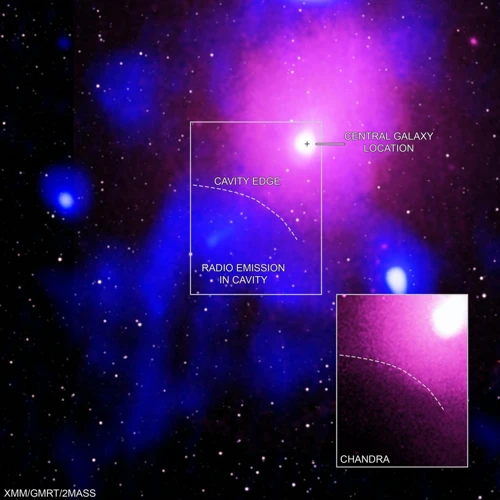
Black holes, the enigmatic celestial objects that defy our understanding of the universe, have long been the subject of fascination and intrigue. Formed from the remnants of massive stars that have exhausted their nuclear fuel, black holes are regions of spacetime with gravitational forces so strong that nothing, not even light, can escape their grasp. To truly comprehend the awe-inspiring nature of black holes, let us take a closer look at their defining characteristics:
- Singularity: At the heart of a black hole lies a singularity, a point of infinite density where the laws of physics as we know them break down. It is a realm where the very fabric of spacetime is crushed to an unimaginable extent.
- Event Horizon: Surrounding the singularity is the event horizon, a boundary beyond which any object that crosses it is forever trapped within the black hole’s gravitational pull. Once an object passes this point of no return, known as the event horizon, it is seemingly lost to the universe.
- Spacetime Curvature: The immense mass of a black hole causes the surrounding spacetime to curve drastically. This curvature dictates the behavior of objects in its vicinity, leading to phenomena such as gravitational lensing, where light is bent and distorted as it traverses the vicinity of the black hole.
- Hawking Radiation (Theoretical): According to Hawking’s theoretical prediction, black holes are not entirely void of activity. Due to quantum effects near the event horizon, they are believed to emit a faint radiation known as Hawking radiation, though this has yet to be directly observed.
The existence of black holes fundamentally alters our perception of space, time, and gravity. Their extreme nature poses captivating questions about the nature of the universe and the limits of our understanding. In the next section, we will explore the intricate connection between gravitational waves and black holes, shedding light on the cosmic phenomena that arise when these two remarkable entities intertwine.
The Connection Between Gravitational Waves and Black Holes
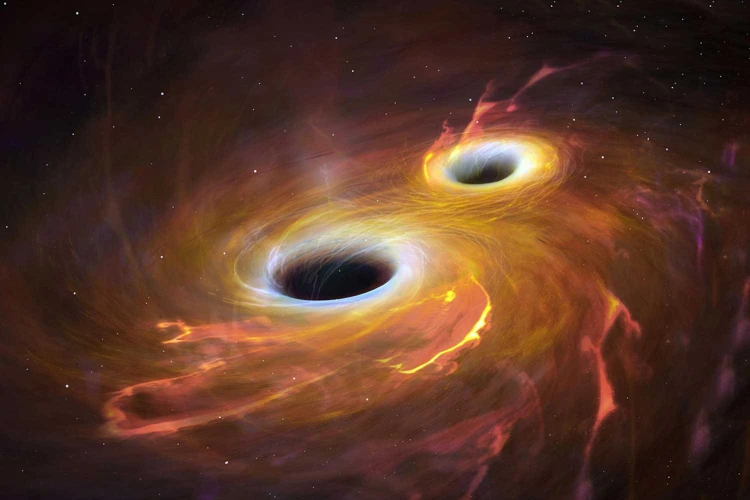
The connection between gravitational waves and black holes is a remarkable and symbiotic relationship that has revolutionized our understanding of these cosmic phenomena. Black holes, as mysterious and powerful gravitational wells, play a crucial role in the production and detection of gravitational waves. When massive objects, such as black holes or neutron stars, orbit each other or collide, they generate ripples in the fabric of spacetime, which are the gravitational waves. These waves carry information about the properties of the objects involved, such as their masses, spins, and velocities.
The detection of gravitational waves has allowed scientists to directly observe and study black holes in ways never before possible. Prior to the discovery of gravitational waves, black holes were primarily studied through their gravitational influence on nearby matter. However, with the advent of gravitational wave observatories like LIGO (Laser Interferometer Gravitational-Wave Observatory), black holes can now be observed and characterized through the gravitational waves they emit.
Gravitational waves provide a unique window into the dynamics and behavior of black holes. By analyzing the gravitational wave signals, scientists can infer the properties of the black holes involved, such as their masses, spins, and even their merger histories. The detection of gravitational waves from merging black holes has confirmed their existence and provided evidence for the existence of binary black hole systems.
The study of black holes through gravitational waves has also revealed the existence of supermassive black holes at the centers of galaxies. These colossal objects with masses millions or even billions of times greater than the Sun have been detected through their gravitational wave signatures. This discovery has significantly contributed to our understanding of galaxy formation and evolution.
The connection between gravitational waves and black holes is an area of active research, with scientists continuously striving to uncover more about the behavior and nature of these cosmic entities. The study of black hole mergers and the observations of gravitational waves emitted during these events have provided valuable insights into the physics of extreme gravitational environments.
As we delve into the implications of gravitational waves and black holes, we unlock new doors to understanding the secrets of the universe. The profound interplay between these two phenomena continues to push the boundaries of our knowledge, opening up possibilities for future discoveries and advancements in our understanding of the cosmos.
Implications of Gravitational Waves and Black Holes
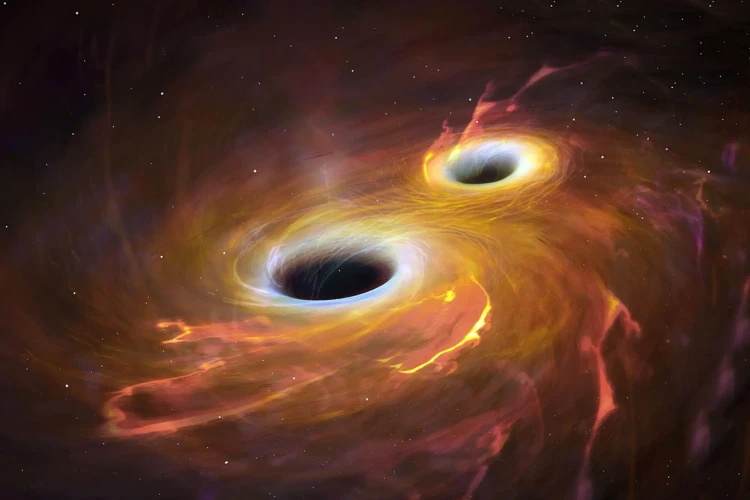
The discovery of gravitational waves and the study of black holes have profound implications for our understanding of the universe. Let’s explore some of the key implications of these cosmic phenomena:
- Confirmation of General Relativity: The detection of gravitational waves provides strong evidence for the validity of Einstein’s theory of general relativity. The behavior of these waves aligns with the predictions made by the theory, confirming its accuracy and providing further support for our understanding of gravity.
- Black Hole Merger Events: Gravitational wave observations have allowed us to detect and study the mergers of black holes. These cataclysmic events produce gravitational waves that provide unique insights into the properties of black holes and the extreme physics involved in their interactions. They have confirmed the existence of binary black hole systems and provided valuable data to study the formation and evolution of these enigmatic cosmic entities.
- Testing Extreme Physics: Black holes, with their immense gravitational pull, allow us to study extreme physics in the universe. The observation of gravitational waves originating from black hole mergers has verified the predictions of general relativity in the strong gravity regime. It has also opened up avenues for exploring alternative theories of gravity and testing the limits of our current understanding of physics.
- Probing the Early Universe: Gravitational waves can provide insights into the early moments of the universe. By studying the cosmic microwave background radiation left over from the Big Bang alongside gravitational wave data, scientists can uncover details about the nature of the universe during its infancy, shedding light on the processes that shaped its evolution.
- Multimessenger Astronomy: The combination of gravitational wave observations with other forms of astronomy, such as electromagnetic or neutrino observations, allows for a comprehensive understanding of astrophysical phenomena. This multimessenger approach provides a more complete picture of cosmic events, enhancing our ability to study and interpret the nature of the universe.
The implications of gravitational waves and black holes are far-reaching, impacting our understanding of gravity, the evolution of the universe, and the nature of extreme astrophysical phenomena. Continued research and advancements in this field promise to uncover even more mysteries and push the boundaries of human knowledge.
Current and Future Research
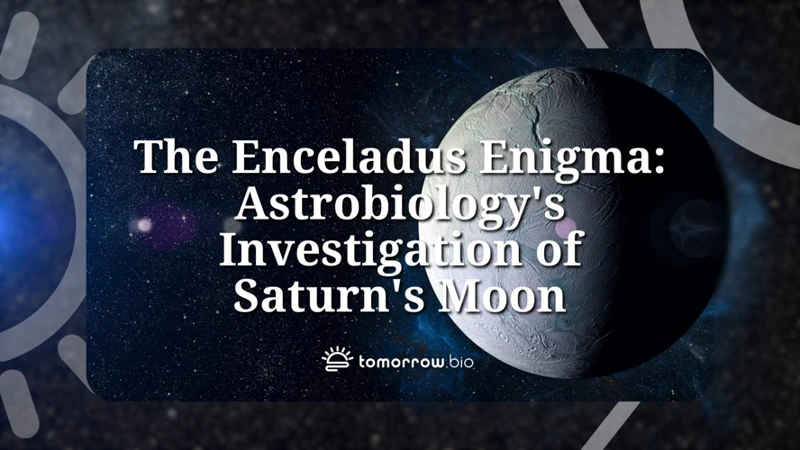
The discovery of gravitational waves has opened up an exciting avenue for scientific exploration and has paved the way for future research in this field. Scientists and researchers are actively engaged in various endeavors to further our understanding of gravitational waves and their connection to black holes. Here are some key areas of current and future research:
- Advanced Gravitational Wave Detectors: Efforts are underway to develop more sensitive and advanced detectors to improve our ability to detect and study gravitational waves. Upgrades to existing detectors, such as the Laser Interferometer Gravitational-Wave Observatory (LIGO), are being carried out, and new detectors, like the European-based Einstein Telescope, are being designed to extend our observational capabilities.
- Multi-Messenger Astronomy: The concept of multi-messenger astronomy involves combining observations of gravitational waves with other forms of astronomical observations, such as electromagnetic radiation, neutrinos, and cosmic rays. This interdisciplinary approach allows for a more comprehensive understanding of cosmic events, enabling scientists to gather complementary information and uncover new insights into the nature of the universe.
- Probing the Early Universe: By studying the Cosmic Microwave Background (CMB), the afterglow of the Big Bang, researchers hope to find signatures of gravitational waves that were generated during the inflationary period of the early universe. This could provide important clues about the conditions that existed shortly after the Big Bang and help validate cosmological theories.
- Testing General Relativity: Gravitational waves offer a unique opportunity to test the predictions of Einstein’s general theory of relativity in extreme gravitational environments. Analyzing the properties of gravitational waves emitted by binary black hole mergers can provide insights into the fundamental nature of gravity and potentially reveal deviations from the predictions of general relativity.
- Black Hole Astrophysics: The study of black holes continues to be a fascinating area of research. Gravitational waves emitted by black hole mergers can provide valuable information about their masses, spins, and populations in different cosmic environments. By observing and analyzing these events, scientists hope to gain a deeper understanding of the formation, growth, and evolution of black holes.
As research in the field of gravitational waves and black holes progresses, new discoveries and advancements are bound to unfold, leading to a deeper understanding of the cosmos and perhaps even unveiling new mysteries that lie hidden in the vastness of the universe. The exploration of this cosmic dance of gravitational waves and black holes holds immense potential for unraveling the secrets of our existence, and it is an exciting time to be at the forefront of gravitational wave research.
Conclusion

In conclusion, the discovery of gravitational waves and the study of black holes have ushered in a new era of astrophysics. The detection and analysis of these elusive waves have provided compelling evidence for the existence of black holes and confirmed Einstein’s theory of general relativity. Through observing the collisions and mergers of black holes, scientists have gained unprecedented insights into the dynamics of these celestial behemoths. Moreover, the ability to detect and study gravitational waves has opened up new avenues for probing the universe and exploring cosmic phenomena that were previously beyond our reach. As research in this field continues to progress, we can expect to unravel even more secrets of the cosmos and deepen our understanding of the fundamental forces and structures that shape our universe. The cosmic dance of gravitational waves and black holes continues to captivate our imaginations and push the boundaries of human knowledge. It is an extraordinary journey that invites us to explore the vastness of space and the mysteries that lie within. So, let us embark on this cosmic odyssey, eagerly awaiting the next revelations that await us on our quest for cosmic understanding.
1. Brief Overview of Black Holes
Black holes, the cosmic marvels that defy our imagination, are regions in space where gravitational forces are so incredibly strong that nothing, not even light, can escape their grasp. These celestial objects, which exist at the end of the life cycle of massive stars, possess a tremendous concentration of matter within a region called the event horizon. Inside this boundary, the gravitational pull becomes so immense that it forms a singularity, a point of infinite density where our understanding of physics breaks down. The formation of a black hole occurs when a massive star undergoes a gravitational collapse, compressing its mass into an incredibly small volume. While black holes were initially theorized by physicist John Michell in the 18th century, it was not until the 20th century that Albert Einstein’s theory of general relativity provided the mathematical framework to understand these cosmic enigmas. Since their discovery, scientists have been awestruck by the peculiar properties of black holes, including their ability to warp spacetime and their role as cosmic phenomena of immense astrophysical importance. As we delve deeper into the connection between gravitational waves and black holes, we will gain a greater appreciation for these enigmatic entities and the extraordinary insights they unveil about the nature of our universe.
2. Formation of Black Holes
Black holes are formed through the extraordinary processes involving the collapse of massive stars or the collisions of dense celestial objects. Understanding the formation of black holes is crucial in unraveling their enigmatic nature. Let’s explore two primary scenarios for the formation of these cosmic entities:
- Stellar Black Holes: When a massive star reaches the end of its life cycle, it undergoes a cataclysmic event known as a supernova explosion. During this explosion, the outer layers of the star are expelled into space, while the core collapses in on itself due to gravitational forces. If the remaining core mass is several times more massive than our Sun, the intense gravity causes it to shrink to a point of infinite density, known as a singularity. This collapse leads to the formation of a stellar black hole, with an event horizon beyond which nothing, not even light, can escape its gravitational pull.
- Supermassive Black Holes: These colossal cosmic entities reside at the centers of galaxies, including our own Milky Way. The exact process behind their formation is still a subject of research and debate, but one theory proposes that they grow through the accumulation and merger of smaller black holes and the accretion of surrounding matter. Over billions of years, these supermassive black holes can reach masses millions or even billions of times greater than our Sun.
The formation of black holes is an awe-inspiring phenomenon that occurs under extreme conditions in the depths of space. By studying their formation and evolution, scientists can gain insights into the nature of gravity, the lifecycle of stars, and the formation of galaxies. The intriguing connection between black holes and gravitational waves will be further explored as we uncover the mysteries behind these cosmic phenomena.
3. The Theory of General Relativity
The Theory of General Relativity:
At the core of our understanding of gravitational waves lies the revolutionary theory of general relativity, formulated by renowned physicist Albert Einstein. Introduced in 1915, this theory fundamentally transformed our perception of gravity. According to Einstein’s theory, gravity is not a force that acts at a distance, as described by Isaac Newton, but rather a consequence of the curvature of spacetime caused by mass and energy. In other words, objects with mass, such as stars or planets, create a ‘dip’ in the fabric of spacetime, causing other objects to move along curved paths. This concept of spacetime curvature provided a profound insight into the nature of gravity, reconciling it with the principles of special relativity.
Einstein’s theory of general relativity predicts that massive objects, when accelerated, produce gravitational waves that propagate through space. These waves are disturbances in the curvature of spacetime itself. The mathematics of general relativity elegantly describes the dynamics of these waves, characterizing their properties and behaviors. The theory also predicts that the speed of gravitational waves is equal to the speed of light, which has been subsequently confirmed by experimental observations.
The groundbreaking theory of general relativity not only laid the foundation for understanding the nature of gravity but also paved the way for predicting the existence of gravitational waves. It set the stage for remarkable advancements in our exploration of the universe, ultimately leading to the discovery and confirmation of gravitational waves. To fully grasp the significance of this milestone, let’s delve into the thrilling journey that culminated in the detection of these elusive cosmic phenomena.
4. Einstein’s Prediction of Gravitational Waves
Albert Einstein, the iconic physicist, predicted the existence of gravitational waves in 1916 as a consequence of his groundbreaking theory of general relativity. In this theory, Einstein proposed that gravity arises from the curvature of spacetime caused by massive objects. He envisioned that when massive objects accelerate or undergo changes in motion, they would emit gravitational waves, propagating outwards and carrying energy away from the source. Einstein’s calculations showed that these waves would travel at the speed of light and manifest as ripples in the fabric of spacetime. However, he realized that detecting such waves would be an immense challenge due to their minuscule size and the technology available at the time. It took several decades of advancements in technology and the development of innovative experimental techniques to finally confirm the existence of gravitational waves, validating Einstein’s remarkable prediction. The quest to directly observe these elusive waves became a driving force behind scientific pursuit, leading to the creation of experiments such as the LIGO project, which would revolutionize our understanding of the universe. To further explore the fascinating journey of detecting gravitational waves, let’s move on to the next section of our cosmic odyssey.
5. The LIGO Experiment
The LIGO Experiment: Unveiling the Cosmic Symphony
The Laser Interferometer Gravitational-Wave Observatory (LIGO) is a groundbreaking scientific endeavor that has revolutionized the field of astrophysics. Its primary objective is the detection and study of gravitational waves, offering a unique window into the secrets of the universe. Here are some key details about this remarkable experiment:
- Principle of Operation: LIGO consists of two identical interferometers located in Livingston, Louisiana, and Hanford, Washington. Each interferometer comprises two perpendicular arms, each measuring 4 kilometers in length. Powerful lasers are split and sent down these arms, where they reflect off mirrors and recombine at a central detector. The interference pattern of the laser light can reveal the minute changes in the lengths of the arms caused by gravitational waves.
- Enhancing Sensitivity: To improve the sensitivity of LIGO, the interferometers are equipped with advanced technology. The mirrors are suspended as pendulums to isolate them from external vibrations, and the arms are evacuated to decrease the effect of air molecules. Additionally, an array of sophisticated instruments and techniques is utilized to minimize noise and maximize the chances of detecting gravitational waves.
- Data Analysis: The enormous amounts of data produced by LIGO require meticulous analysis. Powerful algorithms and computer programs are employed to scrutinize the recorded signals and identify potential gravitational wave events. The data is cross-checked and validated by teams of experts, ensuring the accuracy and reliability of the findings.
- Collaborative Efforts: LIGO is a collaborative project involving scientists and researchers from around the world. The international nature of the experiment allows for greater expertise, resources, and diversity in the pursuit of gravitational wave discovery.
- Discoveries and Milestones: LIGO made history on September 14, 2015, by detecting the first direct gravitational wave signal. This groundbreaking event, caused by the merger of two black holes, confirmed the existence of gravitational waves and opened up a new era of astrophysics. Since then, LIGO has made numerous significant discoveries, observing the merger of binary black holes, binary neutron stars, and other cataclysmic cosmic events.
The LIGO experiment has revolutionized our understanding of the cosmos and propelled gravitational wave astronomy to the forefront of scientific research. With its extraordinary sensitivity and advanced technology, LIGO continues to pave the way for new discoveries and promises to unveil even more secrets of the universe. Discover how the connection between gravitational waves and black holes further expands our knowledge in the next section.
6. Detection of the First Gravitational Wave
In a groundbreaking scientific achievement, the first gravitational wave was detected on September 14, 2015, marking a monumental milestone in our quest to observe these elusive cosmic phenomena. The detection was made by the Laser Interferometer Gravitational-Wave Observatory (LIGO) – a pair of interferometers located in Livingston, Louisiana, and Hanford, Washington, in the United States. The gravitational wave, known as GW150914, originated from the merger of two black holes approximately 1.3 billion light-years away. The collision of these massive objects caused a tremendous release of energy, generating gravitational waves that propagated across the fabric of spacetime. Upon reaching Earth, the waves were detected by the carefully calibrated interferometers at LIGO. The observation of this gravitational wave confirmed the predictions of Einstein’s general theory of relativity and provided substantial evidence for the existence of black holes. This remarkable discovery opened up a new window into the study of the universe, granting us the ability to directly observe the cataclysmic events that shape our cosmos. It paved the way for future detections and further advancements in our understanding of the enigmatic nature of black holes and the universe itself.
7. Observing Black Holes through Gravitational Waves
Observing black holes through gravitational waves has revolutionized our understanding of these mysterious objects. Prior to the advent of gravitational wave astronomy, the study of black holes relied on indirect observations of their effects on surrounding matter. However, the direct detection of gravitational waves has provided a novel and powerful tool for studying black holes in ways that were previously unimaginable.
When black holes merge or interact with other massive objects, such as other black holes or neutron stars, they emit gravitational waves that propagate through space. These waves carry crucial information about the properties of the black holes, such as their masses, spins, and locations. By analyzing the characteristics of the gravitational waves detected, scientists can infer the existence and properties of black holes involved in these cosmic collisions.
One key breakthrough in observing black holes through gravitational waves came in 2015 with the first direct detection of gravitational waves by the Laser Interferometer Gravitational-Wave Observatory (LIGO). The historic event, known as GW150914, was the result of the merger of two black holes, creating a single, more massive black hole. This groundbreaking observation confirmed the existence of gravitational waves and provided the first solid evidence of the existence of black holes.
Since then, numerous other gravitational wave events caused by black hole mergers have been detected, expanding our understanding of these celestial giants. The data collected from these observations has allowed scientists to study the properties of black holes, such as their masses and spins, with unprecedented precision.
Through the analysis of gravitational wave signals, astronomers have been able to determine that black holes come in a range of sizes, with masses ranging from a few times that of our sun to several billion solar masses. They have also discovered that black holes can have different spins, which is a measure of their rotation. These findings and ongoing research have helped refine our models and theories about the formation and evolution of black holes.
The observation of black holes through gravitational waves has opened up a new era of exploration, where we can directly probe the strong gravitational fields of these enigmatic objects. It has provided us with a wealth of data and insights that were previously unattainable, paving the way for further discoveries and a deeper understanding of the nature of black holes and their role in shaping the cosmos.
8. The Collisions of Black Holes
8. The Collisions of Black Holes: Cosmic Cataclysms Unleashed
The collisions of black holes are some of the most cataclysmic events in the universe, unleashing unimaginable amounts of energy and distorting the very fabric of spacetime. When two black holes approach each other, their intense gravitational forces cause them to spiral inwards, forming what is known as a binary black hole system. As this celestial tango continues, the black holes orbit each other faster and faster, emitting gravitational waves that carry away energy from the system.
Over time, the orbits of the black holes decay due to the loss of energy through gravitational wave emission. This gradual inspiral brings them closer together until they eventually collide in a violent merger. The collision unleashes an extraordinary amount of energy in the form of gravitational waves, causing ripples in spacetime that propagate outward at the speed of light.
During the merger, the event horizon of the new, more massive black hole undergoes intense deformations, producing gravitational waves with unique signatures. These gravitational waves carry crucial information about the masses and spin orientations of the merging black holes, allowing scientists to characterize the properties of these enigmatic cosmic objects.
Detecting the gravitational waves produced by black hole collisions has provided a remarkable opportunity to study the dynamics of these elusive entities. Such observations have not only confirmed the existence of black holes but have also unveiled the fascinating phenomena that occur when these cosmic giants collide. By studying these collisions, scientists hope to gain a deeper understanding of black hole formation, evolution, and the nature of extreme gravity.
Through the groundbreaking work of the Laser Interferometer Gravitational-Wave Observatory (LIGO) and other observatories, our knowledge of black hole collisions has expanded exponentially. The detection of these gravitational waves has opened up a new window into the universe, allowing us to explore the deep mysteries of black holes and their cosmic collisions. With continued advancements in technology and the pursuit of future gravitational wave detectors, we can look forward to unraveling even more secrets of these cosmic cataclysms and expanding our understanding of the cosmos itself.
9. Gravitational Waves as Probes of the Universe
Gravitational waves serve as powerful tools for probing the mysteries of the universe, allowing us to observe and study celestial phenomena that were previously inaccessible. Here are some key aspects of how gravitational waves act as probes:
- Black Hole Properties: The detection of gravitational waves has provided us with unprecedented opportunities to study black holes. By analyzing the data from gravitational wave signals, scientists can infer the masses, spins, and merger rates of black holes, shedding light on their formation and evolution.
- Neutron Stars: Gravitational waves offer a unique window into the realm of neutron stars. The merging of neutron stars releases an incredible amount of energy, creating detectable gravitational wave signals. By analyzing these signals, scientists can gain valuable insights into the nature of these dense stellar remnants.
- Cosmic Expansion: Gravitational waves can help us study the expansion rate of the universe. By observing the gravitational wave signals from distant cosmic events, such as mergers of black holes or neutron stars, scientists can measure the distance to these events and track changes in the expansion rate over cosmic time.
- Dark Matter and Dark Energy: Gravitational waves enable us to explore the nature of dark matter and dark energy, two mysterious components that make up the majority of the universe. By studying the effects of gravitational waves on the propagation of light, scientists can gain insights into the properties and distribution of these elusive cosmic phenomena.
- Cosmological Implications: Gravitational waves generated during the early moments of the universe, known as primordial gravitational waves, could provide essential clues about the inflationary period and the fundamental nature of the cosmos itself. Their detection would corroborate theories about the birth and evolution of the universe.
Through these and many other avenues of investigation, gravitational waves have opened up new frontiers in our quest to understand the universe. They allow us to peer into the most extreme cosmic events and phenomena, unveiling the secrets of black holes, neutron stars, and the very fabric of spacetime. As scientists continue to refine their techniques for detecting and interpreting these waves, we can expect even more groundbreaking discoveries that will reshape our understanding of the cosmos.
10. Multimessenger Astronomy
10. Multimessenger Astronomy: A New Era of Cosmic Exploration
Multimessenger astronomy represents a groundbreaking approach to studying the cosmos, leveraging information from various astronomical messengers, including gravitational waves. The discovery of gravitational waves opened up new possibilities for this emerging field of research. By combining data from different messengers, such as electromagnetic waves, cosmic rays, neutrinos, and now gravitational waves, scientists can gain a more comprehensive understanding of astrophysical events.
One of the most notable examples of multimessenger astronomy was the observation of a neutron star merger in 2017. This event, called GW170817, not only produced gravitational waves but also emitted a burst of gamma rays and a wealth of other electromagnetic radiation. The combination of these different messengers provided a wealth of information about the properties and aftermath of the merger.
Multimessenger astronomy allows scientists to piece together a more complete picture of cosmic phenomena. By analyzing the data from different messengers simultaneously, researchers can unlock a treasure trove of knowledge about the origins of black holes, the behavior of neutron stars, and the nature of other celestial objects and events.
The value of multimessenger astronomy lies in the fact that each messenger carries unique information. While gravitational waves directly probe the dynamics of the spacetime fabric, electromagnetic waves reveal the detailed properties of the objects involved. Neutrinos and cosmic rays, on the other hand, provide insight into the energetic processes and particle interactions occurring during cosmic events.
The synergy between different messengers is revolutionizing our understanding of the universe. Combining the data from various messengers allows scientists to verify and validate their findings, uncover new insights, and push the boundaries of our knowledge. It also opens up the possibility of discovering entirely new phenomena that would not be accessible by studying a single messenger alone.
Multimessenger astronomy is an exciting and rapidly growing field, with numerous collaborations and facilities dedicated to the study of cosmic events using a multimessenger approach. As technologies advance and more messengers become accessible, the future of cosmic exploration holds unprecedented potential for unraveling the mysteries of our universe from multiple angles.
Frequently Asked Questions

1. How do gravitational waves differ from electromagnetic waves?
Gravitational waves differ from electromagnetic waves in several ways. Firstly, gravitational waves are caused by the acceleration or movement of massive objects, while electromagnetic waves are produced by the oscillation of electric and magnetic fields. Additionally, gravitational waves can pass through any medium or object without being significantly affected, while electromagnetic waves can be absorbed, reflected, or refracted by certain materials.
2. Can gravitational waves be detected on Earth?
Yes, gravitational waves can be detected on Earth. Advanced scientific instruments, such as the Laser Interferometer Gravitational-Wave Observatory (LIGO), are designed to detect the incredibly subtle distortions in spacetime caused by these waves. LIGO consists of long arms, several kilometers in length, with highly sensitive detectors capable of measuring minuscule changes in distance caused by gravitational waves.
3. How fast do gravitational waves travel?
Gravitational waves travel at the speed of light, which is approximately 299,792 kilometers per second.
4. What are the potential sources of gravitational waves?
Gravitational waves can be generated by various cosmic phenomena, such as the collision of black holes, the merger of neutron stars, supernova explosions, and even the Big Bang itself. These cataclysmic events create ripples in spacetime that propagate as gravitational waves.
5. What can detecting gravitational waves tell us about the universe?
Detecting gravitational waves provides us with crucial insights into the nature of the universe. By studying the characteristics and properties of these waves, scientists can gather information about the objects and events that give rise to them. Gravitational waves offer a unique way to observe and study phenomena that are invisible or difficult to detect using traditional astronomical methods.
6. Can gravitational waves help us understand black holes better?
Yes, gravitational waves have revolutionized our understanding of black holes. By observing the mergers and collisions of black holes through their gravitational wave signatures, scientists have gained unprecedented insights into the properties and behavior of these enigmatic cosmic entities. Gravitational waves have provided concrete evidence for the existence of black holes and have expanded our knowledge of their formation, masses, and spin.
7. How accurate are gravitational wave detectors?
Gravitational wave detectors, such as LIGO, are incredibly accurate. They are capable of measuring changes in distance as small as one-thousandth the diameter of a proton. This level of precision allows scientists to detect even the faintest gravitational wave signals and study them in detail.
8. What is multimessenger astronomy?
Multimessenger astronomy refers to the practice of combining data from different types of astronomical observations, such as gravitational waves, electromagnetic waves, cosmic rays, and neutrinos, to gain a more complete understanding of cosmic events. By correlating multiple sources of information, scientists can paint a more comprehensive picture of the phenomena they are studying.
9. Can gravitational waves be used for communication?
Gravitational waves, due to their extremely weak nature, are not suitable for communication purposes. The disturbances caused by gravitational waves are incredibly subtle and difficult to detect. As a result, it is currently impractical to use them as a means of communication.
10. What can we expect from future research on gravitational waves?
Future research on gravitational waves holds immense promise. Scientists anticipate discovering new gravitational wave sources, refining detection techniques, and gaining deeper insights into the fundamental nature of spacetime and gravity. This research could revolutionize our understanding of the early universe, the behavior of matter under extreme conditions, and the mysteries surrounding phenomena such as dark matter and dark energy.
References
Frequently Asked Questions

1. How do black holes form?
Black holes form from the remnants of massive stars that have exhausted their nuclear fuel and undergo gravitational collapse.
2. Can gravitational waves be seen with the naked eye?
No, gravitational waves cannot be seen with the naked eye as they are not a form of visible light. They are detected using specialized instruments.
3. How fast do gravitational waves travel?
Gravitational waves travel at the speed of light, which is approximately 299,792 kilometers per second.
4. Are all black holes the same size?
No, black holes come in different sizes. The size of a black hole is determined by its mass, with smaller black holes having less mass and larger black holes having more mass.
5. Can gravitational waves pass through matter?
Yes, gravitational waves can pass through matter without being significantly affected. This is one of the reasons why they are such valuable tools for studying the universe.
6. How are black holes detected?
Black holes are detected through their effects on nearby matter or through the detection of gravitational waves emitted by them.
7. Are there any risks associated with gravitational waves?
No, there are no direct risks associated with gravitational waves. They are extremely weak and do not pose any danger to us or our planet.
8. Can black holes collide with each other?
Yes, black holes can collide with each other when they come into close proximity. These collisions can result in the release of gravitational waves.
9. How do gravitational waves provide insight into the early universe?
Gravitational waves provide valuable information about the early universe by allowing us to observe events such as the collision of black holes that occurred billions of years ago.
10. Can gravitational waves be used for communication?
No, gravitational waves cannot be used for communication as they are extremely weak and would be difficult to detect and interpret over long distances.







